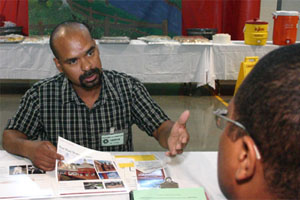Masonry Training in Prisons Reaps Successes
By Brett Martin

While Edwin Collazo was incarcerated in Virginia, he took several vocational classes, including masonry. "I figured I had a lengthy sentence, so there was no sense wasting my time," Collazo said.
Upon his release from prison, he wanted to become an electrician, but it required having his own tools and a van — things he didn't have and couldn't afford. So his masonry instructor at the Virginia Department of Corrections (DOC) arranged a job interview with Southern Brick Contractors Inc. of Richmond, Va. Collazo was hired on the spot. Six and a half years later, he's a foreman with the company, is happily married, owns his own home, and is very appreciative of the masonry trade.
"It worked out for me, and it worked out for Southern Brick," he said. "I love my trade. I love waking up every morning and going to work."
Vocational programs for inmates do work, said Walter A. McFarlane, superintendent of the Virginia Department of Correctional Education (DCE) in Richmond. He said several studies have shown that inmates who complete the masonry program earn more money than those who don't take a training program. Additionally, they are employed at a higher rate, and return to prison at a lower rate.
"One DCE study showed that three years after release, 60 percent of all masonry completers were employed," McFarlane said, although he noted that they may not have all been employed in masonry. "Of the completers, 23.5 percent had returned to prison as compared with approximately 28 percent who had not taken any vocational courses. That is a reduction in recidivism by a factor of 16.1 percent."
"These programs really do work," said Collazo, who's now 40 years old and attends prison job fairs. "If you put in 100 percent, it will reward you."
Southern Brick continues to hire trained inmates; three apprentices now working for the company are former inmates.
"Southern Brick gave me an opportunity and helped me achieve what I achieved," Collazo said. "The pay is good, and I like being able to leave something behind, like a building, that I can be proud of."
Other Virginia inmates may follow his example. Danny, who's taking a masonry class at Virginia's Bland Correction Center, is optimistic about his job prospects.
"I do like the class, and I am glad I had the opportunity to learn the masonry trade. I think it is a great program. This class has given me another option for employment after release," Danny said. "I will be in a field that I can make a lot of money to support me and my family. I plan to pursue a career in masonry, side jobs at first, maybe some work for a contractor. Then, later on, I would like to get my own contractor's license and start a small company of my own."
Jason, also taking the masonry class at Bland, has found the program beneficial as well.
"I have learned a lot since I have been here. It gives me a lot of hands-on experience. It has given me something constructive to do," Jason said. "It really has made me look forward to the next day, and it has helped me refresh upon math I forgot. I plan to pursue a career in masonry. I really enjoy the trade."
Other institutions have reported successes. Duwayne Shoup, the masonry instructor at Mansfield Correctional Institution in Mansfield, Ohio, said his institution has heard back from Career Technical graduates who have been released, and they're finding success in the masonry trade.
"At least one previous student hired on with the local union in the Cleveland area and was making $16 an hour to start," Shoup said. "A recent masonry completer hired on with a non-union company is making $13 an hour, working approximately 60 hours per week. His pay would increase to $17 an hour if he stayed with the company for six months, and after a year would be making $21 per hour. This is a great opportunity since a lot of these students have never had a job prior to being incarcerated."
Steve Ratliff, eastern region director for corrections education at the Kentucky Department of Corrections, Eastern Kentucky Correctional Complex, said keeping track of former inmates' career paths is difficult, but he knows that many have put their masonry training to use.
"We know of some who have entered the trade after release," Ratliff said. "One former student is currently working in our community with a local contractor."
Virginia DCE offers masonry training in two youth and seven adult facilities, said Wayne Bennett, deputy secretary for career and technical education. Adult courses take 10 to 12 months to complete. During the 2005-06 school year, 203 adult students enrolled and 73 completed the program. In the youth schools, 72 enrolled and six completed the program.
Some work takes place on actual projects, such as a two-story concession stand and press box for an athletic field, an addition to a local school, and a reception center.
"They mix and spread mortar, learn to lay brick and block, practice setting corners, develop speed laying to a line, learn typical patterns for brickwork, and laying out work," Bennett said. "There is an emphasis on safety and fundamental math."
And there are similar programs across the nation. The Minnesota Department of Corrections has a masonry program for adult males, said Shari Burt, communications and media relations director in St. Paul. The program focuses on the basic fundamentals of brick and block work. Curriculum includes lectures and hands-on lab work.
"Students in the Basic Block Laying Program learn to lay block on the line, build leads, estimate jobs, plumb and square walls, and lay out first course of blueprints. Students in the Basic Brick Laying Program learn how to lay to the line, build brick leads, plumb and square walls, cut brick using chisel and power saws, and build brick piers and pattern bonds," Burt said. "Students in the Advanced Brick Laying Program learn how to build brick arches, fireplace layout and design, chimney layout and design, stone work, stone veneering, plan reading, and foundation technology."
More than 50 inmates participate in the masonry programs annually.
"During the past calendar year, 31 adult male inmates successfully completed the Basic Block Laying Program, 23 successfully completed the Basic Brick Laying Program, and four successfully completed the Advanced Brick Laying Program," Burt said.
Instructors must have a Brick, Block, and Stone Masonry Vocational Teaching License, she said. The Bricklayers and Allied Craftworkers Local Union business representative provides on-site testing for union certification and job placement assistance.
The Career Technical Class at the Mansfield Correctional Institution in Mansfield, Ohio, teaches a maximum of 18 inmates at a time, with 20 to 25 inmates completing the training each year, said Shoup.
Shoup has been teaching masonry at Mansfield for 16 years, after working in the field for 13 years. The training program prepares inmates for real-world masonry jobs.
"Student projects range from 48-inch, three-course walls, to single and corner leads with block and brick. As students gain new skills, they work with composite brick walls with corresponding piers, lock sills, and top walls with Roman arches," Shoup said. "Completers are capable of receiving entry-level jobs upon release."
Like other correctional institutions, Mansfield holds job fairs where masonry students can meet potential employers.
The Kentucky Department of Corrections, Eastern Kentucky Correctional Complex, in West Liberty, Ky., provides masonry training to nearly three dozen inmates annually. "We try to carry 15 full-time students at all times," said Ratliff. "Student population is very transient. We usually enroll 30 to 35 per year into the program."
The curriculum requires several hours of General Education courses, which are eligible for college credits, Ratliff said.
"I would consider it expert training. Students work toward a diploma or AAS [Associate of Applied Science degree] in the program," he said. "It is not a basics program; they simulate real job situations in our lab."
In the school year 2005-06, the South Carolina Department of Corrections, Perry Correctional Institution, in Pelzer, S.C., enrolled 444 inmates in vocational programs, including masonry, and 160 inmates completed the courses and received certificates, said Weyland Burns, acting division director, education division.
The masonry training, taught by qualified brick masons, covers brick and block basics such as corners and arches, lay to the line and fireplaces, Burns said.
One program that could really benefit from an experienced mason is at the Mississippi State Penitentiary (MSP) in Parchman, Miss., which has been inactive for the past two years because it lacks an instructor, said Kent Crocker, communications specialist for the Mississippi Department of Corrections in Jackson, Miss.
"Our program at Mississippi State Penitentiary could be an active program if a qualified instructor applies and meets the requirements," Crocker said. "A person must show expertise in the field of masonry and bricklaying and have documentation of this expertise. They would need to have a minimum of four years of verifiable work in masonry and bricklaying along with other requirements, such as being able to obtain a vocational teaching license."
When the program was active, 15 inmates could enroll at a time to complete the 1,800 hours of training, which took approximately 18 to 19 months, he said.
Training included specialized classroom and shop experiences, such as laying out and spacing bonds; determining vertical and horizontal alignment of courses using gauges, plumb bobs, and levels; and cutting, notching, and shaping blocks, bricks, and stone to construct or repair walls, partitions, arches or fireplaces, Crocker said. Training also entailed reading architectural plans, planning and estimating.
Other programs also welcome mason contractor and mason contributions. Shoup said masonry professionals are always welcomed to be part of the class Advisory Committee at the Mansfield Institution. Masons and mason contractors are also considered as guest speakers.
The Kentucky DOC welcomes mason contractors interested in helping to train inmates, Ratliff said. Although the institution does not currently work with state or local masonry businesses to help secure employment for released inmates, that could soon change. In March, a transition coordinator was hired to help with job placement.
"He is charged with starting a program with contractors statewide to provide these very services to our released students," Ratliff said.
About the Author
Brett Martin is a freelance writer located in Shakopee, Minn. with several years of construction and writing experience.
In the interest of privacy, some of those interviewed for this article have withheld their last name.


















